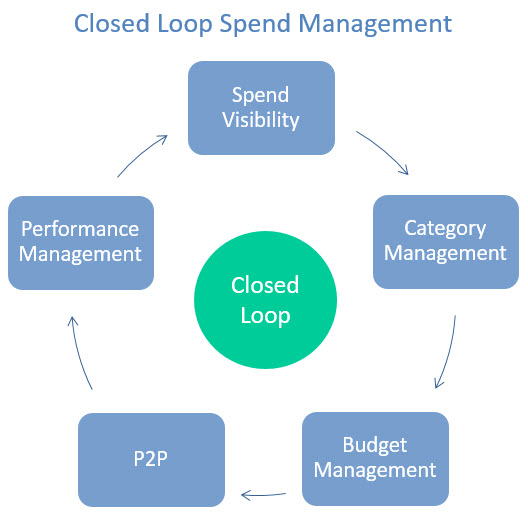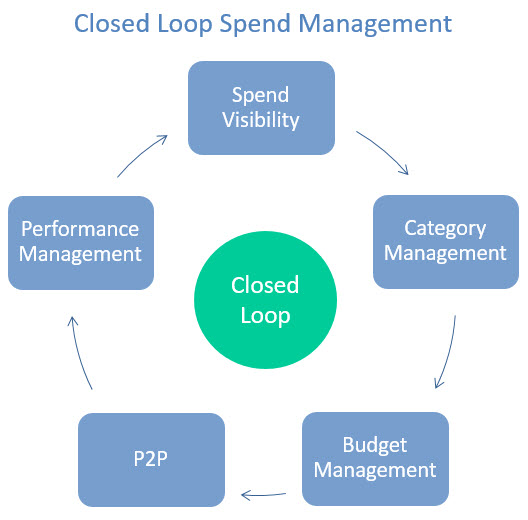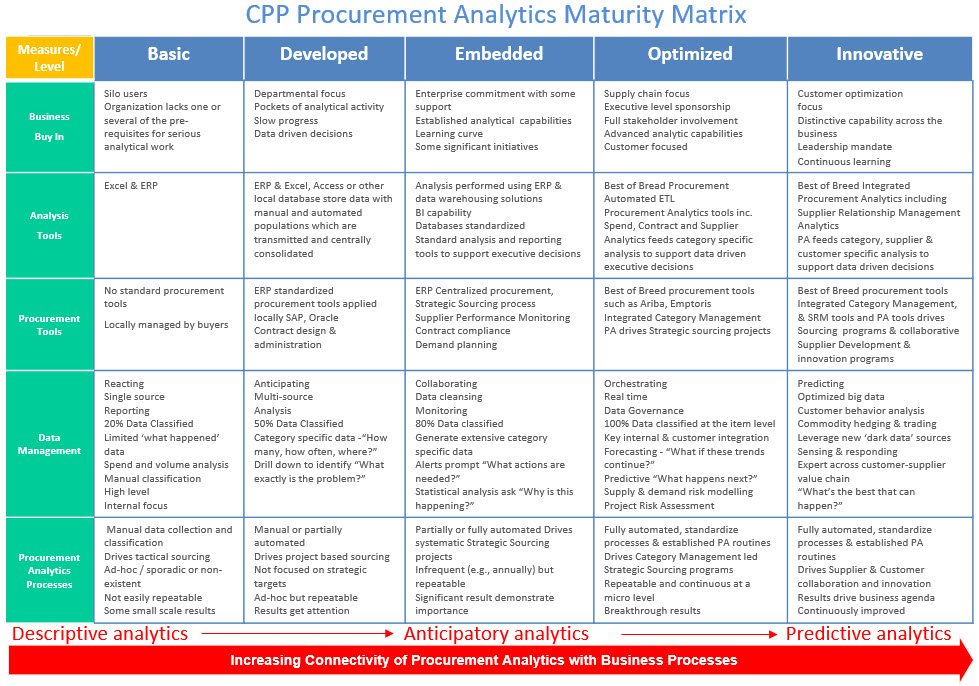Part 2: Procurement Analytics Maturity Matters:
Beyond simple spend data towards strategic decisions and value
In our previous post, we discussed the business case for Procurement Analytics. Here in this post we discuss the why Procurement Analytics Maturity Matters and the challenges and maturity levels in building Procurement Analytics capability.
1. Procurement Analytics Maturity Matters
Companies are competing on analytics
In virtually every industry, many former competitive strategies are no longer a source of competitive advantage. Today, proprietary technologies are rapidly replicated by competitors (think Apple & Google with IOS v Andriod in software or Apple and Samsung in hardware), and breakthrough innovation in either products or services is rare.
Today most companies are employing optimization of key business processes as a key source of competitive advantage. Instead of serving all customers, businesses want to serve optimal customers—those with the highest level of profitability and lifetime value.
The optimization of business processes means:
- Optimizing supply chains to minimize disruptions and in-process inventory;
- Transactional efficiency;
- Taking a predictive view to understand how optimum nonfinancial performance drives optimum financial performance;
- Optimize use of capital.
But strategies involving optimization will not work by taking business as it comes. Above all, they require extensive data on the performance of the business, it’s environment and the company’s place within it. Extensive analysis of the data to generate insights and the creation of new knowledge to identify opportunities and guide executive decision-making that start initiatives to capture value ahead of their competitors.
Companies that focus on optimizing their business performance using this data-intensive approach are competing on analytics and analytical capabilities.
2. Challenges
Hackett Group reported that most companies procurement analytics face two major challenges that require extensive human support; data accuracy and data source interconnectivity.
Many companies still struggle to deal with the data demands of increasingly complex supply chains, multiple ERP systems, and data warehouses, that provide a consolidated overview of the company’s historical supplier payment data. Combine this with organizational barriers, and it is not surprising that they struggle to discover insights that reveal something new or enable Buyers to raise questions they would have never thought to ask. As Fig 1 below shows, challenges occur in three primary areas; Organization, Coding and Classification and Growth through Merger & Acquisition:
More often than not, decision makers lack confidence in their spend data due to the manual nature of consolidation and cleansing. Furthermore, lack of visibility and access resulting from a decentralized supplier payment organization leaves many CPO’s and CFO’s suffering from myopia over their spend data.
In our experience, there are companies with subscriptions to dozens of supplier and business information services, but they are still blind to supplier risks because this data is not tied to their business processes. There are companies that spend millions creating and negotiating optimal contracts but then can’t enforce compliance with the terms of those contracts. Consequently, their organizations miss competitive opportunities, are more vulnerable to financial and operational risks, and they are forced to react to internal operational pressures and market movements.
These are common problems at global companies – all of which can be significantly improved or solved with a Procurement Analytics capability.
3. The Promise of Procurement Analytics
Imagine, when you launch a strategic sourcing initiative that you no longer need to ask the IT function to run reports to provide data that is hard to analyze and not fit for purpose. Imagine you no longer need to send out internal RFI’s to collect data from stakeholders around the organization and wait for their responses that are usually, incomplete. Also, imagine that you no longer have to send out external RFI’s to collect historical data from suppliers. Furthermore, imagine you don’t have to load all this data into spreadsheets and spend hours translating it into actionable data.
Now imagine that you can pull up this data in real-time. Data revealing suppliers used, price history, usage by month, by a site, by GL code, etc. You can see there is a contract in place, and you can see on and off contract purchases to track compliance.
Finally, imagine that those data sources are interconnected, able to enrich each other automatically. To ‘learn’ from other sources i.e. leverage further market intelligence from social networks, websites, devices, and subscription databases that deliver rich data to category managers and analyst.
So instead of learning that you have too many suppliers fragmenting your spend. You can now get a “Big Picture View” with an emphasis on strategic cost reduction and focused on total cost that shows:
- You can massively reduce your supplier base;
- This rationalization can be done by aggregating spend with suppliers identified as delivering superior performance than many of your existing suppliers;
- You can renegotiate your contracts with supplier 1+2+3 bundling your volume because supplier 1 acquired 2 and 3;
- You should start renegotiating contract D & E because they will expire in 6 months from now.
With Procurement Analytics automated data maintenance, you can reduce your sourcing cycle time and all these benefits can become your new normal.
4. Following the Leaders
Senior management is committed to developing a distinctive analytics capability. While taking an enterprise-wide approach, they address visibility issues through a single centralized platform connected to the company’s purchasing, sourcing, contract management, and performance tracking systems.
They harness the entire procurement value chain in a closed-loop spend management system (Fig 2). This approach provides a real-time view of what is being purchased, from whom and at what price, and the associated contract terms and they track compliance and budgetary impact.
This closed loop approach is enabled through investment in Procurement Analytics solutions that provide spend visibility to leverage synergies throughout the procurement process. By leveraging this visibility, Procurement Analytics permits leaders to reallocate resources away from manual data manipulation to higher value-add analytics:
- Manually tracking contract compliance by comparing AP information and purchase order systems with paper contracts, or contracts not centrally stored is no longer required.
- Now the reallocation of resources to strategic activities such as category management, strategic sourcing, and supplier relationship management, that drive significant value to the bottom line is possible, and so they gain a further advantage.
Procurement Analytics enables leaders to achieve better results and identify larger savings opportunities whatever the market conditions.
4.1 Analytics Capability & Maturity
An analytical capability is not something an organization either has or lacks. There are several stages of analytical capability development. The CPP Procurement Analytics Maturity Table (Fig 3) shows five levels of capability based on the impact on business results by providing insights to improvement opportunities.
Once procurement professionals have access to advanced procurement intelligence on the go, things start to accelerate. They quickly understand the kinds of questions to ask that they either couldn’t, or never thought of asking before. They can then set up scenarios and experiments to plan for and collect data that unlocks new knowledge and opportunities that create superior business results.
5. Conclusion
Analytical competition opportunities are available in every industry. CPO’s seeking to create a competitive advantage using a Procurement Analytics strategy should begin working on it now. Taking advantage of today’s powerful Procurement Analytics solutions to overcome the historical barriers to gathering and managing data from internal and external sources, using the latest ‘Extract, Transform, Load’ (ETL) technology.
CPO should consider how they might adopt Procurement Analytics and develop their capabilities. A starting point is to consider what could be done if data were available and evaluate if you have the right data today. The next step is to make the business case and invest in a procurement analytics solution.
That increasingly more companies are competing on their supply chains is well publicized, the question for each and every CPO is ‘do you have the data to optimize yours’?
Nuff said ..
If you would like to discuss how we can solve your Procurement Analytics requirements visit our web page or contact us.
In our next post we will discuss ‘how to build a Procurement Analytics strategy’




